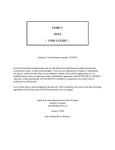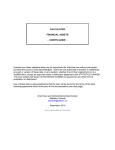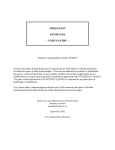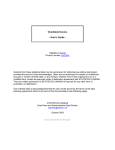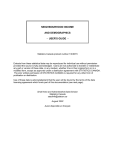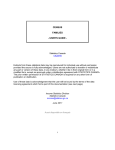Download User's Guide
Transcript
NEIGHBOURHOOD INCOME AND DEMOGRAPHICS ) USER'S GUIDE ) Statistics Canada product number 13C0015 Extracts from these statistical data may be reproduced for individual use without permission provided the source is fully acknowledged. Users are not authorized to transfer or redistribute any part or version of these data, in any medium, whether it be in their original form or in a modified form, except as approved under a distribution agreement with STATISTICS CANADA. The prior written permission of STATISTICS CANADA is required for any other form of publication or distribution. Use of these data is acknowledgment that the user will be bound by the terms of the data licensing agreement which forms part of this documentation (see next page). Small Area and Administrative Data Division Statistics Canada [email protected] July 1997 Aussi disponible en français LIMITED USE DATA PRODUCT LICENCE AGREEMENT The Government of Canada (Statistics Canada) is the owner or a licensee of all intellectual property rights (including copyright) in this data product. In consideration of your payment of the requisite fee, you or your organization, as the case may be, (hereinafter referred to as the “licensee”) are granted a non-exclusive, non-assignable and non-transferable licence to use this data product subject to the terms below. This licence is not a sale of any or all of the rights of the owner(s). This data product may be used only by you or your organization, as the case may be. No part of the data product nor any right granted under this agreement shall be sold, rented, leased, lent, sub-licensed or transferred to any other person or organization. The licensee shall not use any part of the data product to develop or derive any other data product or data service for distribution or commercial sale, without a licence to do so. The licensee may not disassemble, decompile or in any way attempt to reverse engineer any software provided as part of the data product. The licensee may not transfer this data product to or store the data product in any electronic network for use by more than one user unless it obtains prior written permission from Statistics Canada and pays any additional fees. This data product is provided “as-is,” and Statistics Canada makes no warranty, either express or implied, including but not limited to, warranties of merchantability and fitness for a particular purpose. In no event will Statistics Canada be liable for any indirect, special, consequential or other damages however caused. This agreement will terminate automatically without notice if the licensee fails to comply with any term of this agreement. In the event of termination, the licensee must immediately return the data product to Statistics Canada or destroy it and certify this destruction in writing to Statistics Canada. It is YOUR RESPONSIBILITY to ensure that your use of this data product complies with these terms and to seek prior written permission from Statistics Canada for any uses not permitted or not specified in this agreement. ANY USE WHATSOEVER OF THIS DATA PRODUCT SHALL CONSTITUTE YOUR ACCEPTANCE OF THE TERMS OF THIS AGREEMENT. For further information please contact: Licence Services Marketing Division Statistics Canada Ottawa, Ontario Canada, K1A 0T6 Tel: 613-951-8211 Fax: 613-951-1134 Revised on December 11, 1996 i TABLE OF CONTENTS PRODUCT LICENCE AGREEMENT . . . . . . . . . . . . . . . . . . . . . . . . . . . . . . . . . . . . . . . . . . . i INTRODUCTION . . . . . . . . . . . . . . . . . . . . . . . . . . . . . . . . . . . . . . . . . . . . . . . . . . . . . . . . . . 1 SECTION I ) THE DATA . . . . . . . . . . . . . . . . . . . . . . . . . . . . . . . . . . . . . . . . . . . . . . . . . . . . 2 Data Source . . . . . . . . . . . . . . . . . . . . . . . . . . . . . . . . . . . . . . . . . . . . . . . . . . . . . . . . . . 2 Data Currency . . . . . . . . . . . . . . . . . . . . . . . . . . . . . . . . . . . . . . . . . . . . . . . . . . . . . . . . 2 Data Quality . . . . . . . . . . . . . . . . . . . . . . . . . . . . . . . . . . . . . . . . . . . . . . . . . . . . . . . . . . 2 Confidentiality and Rounding . . . . . . . . . . . . . . . . . . . . . . . . . . . . . . . . . . . . . . . . . . . . . 7 Suppressed Data . . . . . . . . . . . . . . . . . . . . . . . . . . . . . . . . . . . . . . . . . . . . . . . . . . . . . . 7 SECTION II ) THE DATA TABLES . . . . . . . . . . . . . . . . . . . . . . . . . . . . . . . . . . . . . . . . . . . 9 A ) Number of Tables . . . . . . . . . . . . . . . . . . . . . . . . . . . . . . . . . . . . . . . . . . . . . . . . . . 9 B ) Data Table Contents . . . . . . . . . . . . . . . . . . . . . . . . . . . . . . . . . . . . . . . . . . . . . . . 10 SECTION III ) GLOSSARY OF TERMS . . . . . . . . . . . . . . . . . . . . . . . . . . . . . . . . . . . . . . . 11 SECTION IV ) GEOGRAPHY . . . . . . . . . . . . . . . . . . . . . . . . . . . . . . . . . . . . . . . . . . . . . . . Geographic levels ) postal geography . . . . . . . . . . . . . . . . . . . . . . . . . . . . . . . . . . . . . "Vintage" of the postal walks . . . . . . . . . . . . . . . . . . . . . . . . . . . . . . . . . . . . . . . . . . . . Geographic levels ) Census geography . . . . . . . . . . . . . . . . . . . . . . . . . . . . . . . . . . . . Geographic levels ) special geography . . . . . . . . . . . . . . . . . . . . . . . . . . . . . . . . . . . . . 19 20 24 25 27 WE INVITE YOUR COMMENTS . . . . . . . . . . . . . . . . . . . . . . . . . . . . . . . . . . . . . . . . . . . . . 28 List of Statistics Canada Regional Offices . . . . . . . . . . . . . . . . . . . . . . . . . . . . . . . . . . 29 LIST OF DATA PRODUCTS AVAILABLE . . . . . . . . . . . . . . . . . . . . . . . . . . . . . . . . . . . . . 30 ii INTRODUCTION Neighbourhood Income and Demographics contains counts and income data for all taxfilers and dependents reporting income. Also included are demographic data on the Canadian population, such as marital status, gender, age groups and single years of age. The information is accurate and current. It is obtained from income tax records and is updated annually. These data will be a valuable aid to anyone assessing the sociological and financial status of residents in the geographic area of interest to them. 1 SECTION I ) THE DATA Data Source The data are derived from income tax returns. For the most part, tax returns were filed in the Spring of the year following the reference year. The mailing address at the time of filing is the basis for the geographic information in the tables. New to the product beginning with 1992 data are demographic statistics for the both taxfilers and dependents. These statistics are derived from the Small Area and Administrative Data Division family databank built from the income tax records. For data of previous years (up to and including 1991), demographic statistics were provided for taxfilers only. Data Currency Since the data are taken from tax records, they are current data from tax returns filed for the year noted on the tables. For example, 1995 income records are taken from 1995 tax returns filed in Spring of 1996, with data released in July 1997. Data are always current, since they are updated on an annual basis. Data Quality The data appearing in the tables are taken directly from the Small Area and Administrative Data Division family databank, built from the income tax and the Child Tax Benefit records. Information on income is obtained from the taxfilers, for both themselves and their non-filing spouses. Demographic information is derived from taxfilers and non-filing dependent spouses and/or children, such as the estimates of "total taxfilers and dependents". In 1995, almost 69% of Canadians (of all ages) filed tax returns (see figure 1). Most children do not file because they have low or no income. Similarly, some elderly Canadians receiving only Old Age Security (OAS) and Guaranteed Income Supplement (GIS) do not file because they have low or no taxable income. However, with the introduction of the Federal Sales Tax Credit in 1986 and the Goods and Services Tax Credit in 1989, the percentage of the elderly population filing tax returns has increased. In 1995, 87% filed tax returns, up from 75% in 1989. 2 FIGURE 1 ) COVERAGE Tax year Number of Taxfilers ('000) Date of Population Estimate Population ('000) Coverage (%) 1989 18,059 April 1, 1990 27,669 65.3 1990 18,450 April 1, 1991 28,025 65.8 1991 18,786 April 1, 1992 28,422 66.1 1992 19,267 April 1, 1993 28,831 66.8 1993 19,882 April 1, 1994 29,173 68.2 1994 20,184 April 1, 1995 29,533 68.3 1995 20,536 April 1, 1996 29,867 68.8 Percent coverage is based on a comparison of the number of taxfilers in the Small Area and Administrative Data Division's taxfiler databank and the latest population estimates from the Statistics Canada publication Quarterly Demographic Statistics (catalogue no. 91-002). The initial population used to develop the estimated population counts comprise all taxfilers for the reference year and represents over two-thirds of the Canadian population. Taxfilers from the same family including children are matched using common links (e.g. same name, same address). When there are indications that one or several members of a family are missing (for instance children), those members are imputed. The remaining taxfilers who have not been matched in the family formation process become non-family persons. The resulting population counts approximate the total Canadian population. The Small Area and Administrative Data family databank population estimates compare well with estimates obtained through other sources. For example, coverage rates by age from the databank, compared to the official population estimates, are: 3 FIGURE 2 ) COVERAGE BY AGE AND BY PROVINCE 1995 Rates of Coverage by Age 1995 Rates of Coverage by Province under 20 20-24 25-29 30-34 35-39 40-44 45-49 50-54 55-59 60-64 65-74 75+ 100% 89% 91% 95% 95% 96% 95% 93% 94% 95% 96% 90% Newfoundland Prince Edward Island Nova Scotia New Brunswick Quebec Ontario Manitoba Saskatchewan Alberta British Columbia Yukon Territory Northwest Territories 98% 98% 97% 98% 96% 95% 98% 98% 97% 95% 95% 95% Total 96% Canada 96% % coverage by age is based on a comparison with the estimated population counts to July 1, 1996 from Statistics Canada catalogue number 91-213-XPB, Annual Demographic Statistics. Coverage by province is based on a comparison with the estimated population counts to April 1, 1996 produced by the Demography Division of Statistics Canada. Individuals Beginning in 1992, Total Income was changed to include income of non-filing spouses reported on the taxfiler's income tax return. This increased the population of lower income individuals, subsequently lowering the median total income of the population. See the following table (figure 3). 4 FIGURE 3 ) MEDIAN INCOME, INDIVIDUALS Year Median Income, Individuals % ratio (T1FF/SCF) T1FF SCF 1989 18,100 17,806 101.7 1990 19,100 18,552 103.0 1991 19,300 18,817 102.6 1992 18,600 19,438 95.7 1993 18,000 19,164 93.9 1994 18,500 19,587 94.5 1995 18,900 20,134 93.9 Note: SCF (Survey of Consumer Finances) medians are from Statistics Canada's annual publication 13-207, Income distributions by size in Canada. T1FF medians are from the individual databank. Families The introduction of the Federal Sales Tax Credit in 1986 and the Goods, and Services Tax Credit in 1989, has resulted in more low income families filing tax returns. This has caused the median family income figures for T1FF up to 1991 to be lower than the Survey of Consumer Finances (SCF). Beginning in 1992, family total income was changed to include income of non-filing spouses reported on the taxfiler's income tax return. This has caused an increase in family total income as well as and increase in median income for 1992 as reflected in the following table (figure 4). 5 FIGURE 4 ) MEDIAN INCOME OF FAMILIES Median Income, all Families Year % ratio (T1FF/SCF) T1FF SCF 1990 42,700 44,783 95.3% 1991 42,900 45,368 94.6% 1992 43,500 46,175 94.2% 1993 43,000 45,583 94.3% 1994 43,200 46,908 92.1% 1995 44,300 47,124 94.0% Note: The above T1FF medians are taken from the family databank being discussed here; the Survey of Consumer Finances (SCF) medians are from Statistics Canada's annual publication 13-208: Family Incomes, Census Families. The SCF estimates do not include the Territories, and so they were also excluded from the T1FF figures above. In comparing transfer payment totals to 1995 figures from other data sources, it is evident that our coverage is high. FIGURE 5 ) TRANSFER PAYMENT COVERAGE Transfer Payment Coverage Unemployment Insurance Benefits Child Tax Benefits (CTB) Old Age Security Benefits CPP/QPP Benefits Social Assistance Workers' Compensation 90% 100% 88% 92% 79% 97% Sources: Annual Statistics on the Canada Pension Plan and Old Age Security, Income Security Programs, Human Resources Development Canada; Unemployment Insurance Statistics, Statistics Canada catalogue number 73-202; Provincial Economic Accounts, Statistics Canada catalogue number 13-213. 6 Confidentiality and Rounding Since 1990, data cells represent counts greater than 15, and are rounded to a base of 10. For example, a cell count of 16 would be rounded to 20 and a cell count of 24 would be rounded to 20. For 1988 and 1989 data, all counts are 25 or greater and are rounded to the nearest 25. All reported amounts are rounded to the nearest thousand dollars. For data up to and including 1987, all counts are randomly rounded to a base of 5, and reported amounts are unrounded, but are adjusted according to the rounding of the counts. Note: Counts represents the number of persons filing tax returns (taxfilers). Reported amounts are dollar amounts reported by taxfilers. Suppressed Data To maintain confidentiality, some data cells have been suppressed whenever: ) areas comprise less than 100 taxfilers; ) cells represent less than 15 taxfilers; ) cells were dominated by a single filer. Suppressed data may occur: i) within one area: ) when one of the income categories is suppressed, a second category must also be suppressed to avoid disclosure of confidential data by subtraction (called residual disclosure) (see figure 6); ) when one of the gender categories is suppressed, the other gender category must also be suppressed to avoid disclosure (see figure 6); ii) between areas: ) when a variable amount in one area is suppressed, that variable amount is also suppressed in another area to prevent disclosure by subtraction. 7 FIGURE 6 ) SUPPRESSION OF INCOME DATA Amount (Millions of Dollars) Males Females Total Wages/Salaries/Commissions Self-Employment Dividends and Interest Unemployment Insurance Old Age Security/Net Federal Supplements Canada/Quebec Pension Plan Other Pensions Child Tax Benefits Goods and Services Tax Credit Workers' Compensation Social Assistance Provincial Refundable Tax Credits RRSP Income Other Income 6.7 0.3 1.2 0.7 0.7 1.1 1.9 x x** 0.1 0.2 0.1 0.1 0.6 3.4 0.2 1.1 0.3 0.5 0.5 0.4 x* x** 0.1 0.2 0.1 0.1 0.6 10.2 0.5 2.3 1.0 1.1 1.6 2.3 0.1 0.2 0.2 0.5 0.2 0.2 1.2 Total Income 14.5 7.8 22.3 x ) Confidential when reported by fewer than 15 taxfilers. (In machine readable format, the suppressed cell will contain a "0".) x* For the same income variable, the value for the opposite gender was suppressed in the table to avoid disclosure by subtraction. x** The value for a second income variable was suppressed elsewhere in the table to avoid disclosure by subtraction. 8 SECTION II ) THE DATA TABLES A ) Number of Tables Beginning with the 1994 data, the maximum number of tables for each area is reduced from nine to five. It is important to note that this reduction in tables has not resulted in any loss of information from previous years. A reformatting of existing tables was the primary reason for the change. The table topics are the following: 1. Summary table, including data for five categories of the population: a) taxfilers and dependents b) taxfilers c) total income d) persons reporting employment income and/or Unemployment Insurance benefits e) persons reporting Child Tax Benefits 2. Taxfilers and dependents by marital status and by age group 3. Taxfilers and dependents by single year of age 4. Taxfilers and dependents by source of income 5. Taxfilers and dependents by total income, sex and age group Demographic characteristics are given for the total population in tables 1a, 2 and 3. Income distributions and sources of income are given for those taxfilers reporting some income and for non-filing spouses of taxfilers of those who's income is reported on the taxfiler record (tables 1c, 4 and 5). For persons with employment income, medians by gender are given (table 1c). 9 B ) Data Table Contents Population ) Demographic Characteristics Demographic characteristics are given for the total population. The data are from the Small Area and Administrative Data Division family databank, built from the income tax records. Taxfiler counts are still provided on the summary table (table 1). For data prior to 1992, demographic characteristics are provided for taxfilers only. The marital status "Common Law" is reported in table 2. This is as a result of Revenue Canada providing taxfilers with a separate box permitting common law couples to indicate their marital status. For data prior to 1992, it is undetermined where common law couples would have reported their marital status on the individual income tax return. Characteristics such as age and marital status are as of December 31 of the reference year. Total Income Explanatory notes regarding total income and the changes to this variable are given in the Glossary section, under "Total Income". Other Notes on Tables Table 1, percent in apartments: it should be noted that this type of mail delivery service is identified by Canada Post, and applies to apartments with 50 or more units. Table 2, marital status "single": the information by gender usually does not add to the total shown because the gender of the younger population is, in many cases, not known. This situation occurs primarily with the young dependents who are identified through the tax return of their parents, and where gender information is not provided. Tables 2 and 3, ages 0-19: the information by gender is incomplete, primarily because of dependent children identified through the tax return of the parent, where gender information is missing. 10 SECTION III ) GLOSSARY OF TERMS AGE is calculated as of December 31 of the reference year (i.e., tax year minus year of birth). In the "Single Years of Age" table (table 3), counts of children aged 0 to 18 are not rounded, and the other ages of the population are rounded to the nearest 5. CANADA/QUEBEC PENSION PLAN (CPP/QPP) are compulsory contributory social insurance plans that protect workers and their families against loss of income due to retirement, disability or death. Canada Pension Plan and Quebec Pension Plan benefits include all benefits reported for the reference year. CENSUS DIVISIONS See section on Geography. CENSUS METROPOLITAN AREAS See section on Geography. CHILD TAX BENEFIT (CTB) is a system that replaces (beginning with the 1993 data year) the previous Family Allowance program, the non-refundable child deduction and the refundable Child Tax Credit. It is an income supplement for individuals who have at least one qualified dependent child. The Child Tax Benefit is also based on the individual's family income and the number of dependent children. COUNTS Indicates the number of persons or items represented in a variable (e.g., the number of taxfilers reporting income in the year in question). DEPENDENTS For the purposes of these databanks, dependents are the non-filing members of a family that have been identified through the tax system. We do not attempt to measure dependency in any way, but are able to identify certain non-filing family members, and include these in the total counts of people in a given area. 11 DIVIDEND INCOME includes dividend income from taxable Canadian corporations (such as stocks or mutual funds) as reported on line 120 of the personal income tax return, and then grossed down to the actual amounts received; dividend income does not include dividends received from foreign investments (which are included in interest income and reported on line 121). EMPLOYMENT INCOME is the total reported employment income. Employment income includes wages and salaries, commissions from employment, training allowances, tips and gratuities, and selfemployment income (net income from business, profession, farming, fishing and commissions). FORWARD SORTATION AREA (FSA) See section on Geography. GOODS AND SERVICES TAX (GST) CREDIT includes all amounts received through this program. In 1990, the Goods and Services Tax Credit began replacing the Federal Sales Tax (FST) Credit. By 1991, the FST Credit no longer existed. INDEX is a comparison of the variable for the given area with either the province (province = 100) or with Canada (Canada = 100). INTEREST INCOME refers to the amount Canadians claimed on line 121 of the personal income tax return. This amount includes interest generated from bank deposits, Canada Savings Bonds, corporate bonds, treasury bills, investment certificates, term deposits, annuities, mutual funds, earnings on life insurance policies and all foreign interest and foreign dividend incomes. INVESTMENT INCOME includes both interest income and dividend income. LABOUR FORCE 12 consists of all persons who reported income from employment (wages, salaries, commissions and self-employment income) or income from Unemployment Insurance. LEVEL OF GEOGRAPHY is a code designating the type of geographic area to which the information in the table applies. See the section on Geography for further information. MEDIAN is the middle number in a group of numbers. Where a median income, for example, is given as $26,000, it means that exactly half of the incomes reported are greater than or equal to $26,000, and that the other half are less than or equal to the median amount. Median incomes in the data tables are rounded to the nearest hundred dollars. With the exception of "Total Income", zero values are not included in the calculation of medians for individuals, but are included in the calculation of medians for families. NET FEDERAL SUPPLEMENTS are part of the Old Age Security (OAS) pension program, intended to supplement the income of pensioners and spouses with lower income; payments take the form of a Guaranteed Income Supplement (GIS) or a Spouse's Allowance (SPA). NON-TAXABLE INCOME/PROVINCIAL (REFUNDABLE) TAX CREDITS Non-taxable income refers to the amounts included in a taxfiler's income when applying for refundable tax credits, but not included in the calculation of taxable income; these amounts include Workers' Compensation payments, Net Federal Supplements received (Guaranteed Income Supplements and/or Spouse's Allowance), and social assistance payments. Beginning with the 1994 data, information is available separately for Net Federal Supplements, Workers' Compensation and social assistance. Provincial tax credits are a refundable credit paid to individuals by the province in which he/she resided as of December 31 of the taxation year. See also "Provincial refundable tax credits". OLD AGE SECURITY (OAS) PENSION 13 is part of the Old Age Security program, a federal government program that guarantees a degree of financial security to Canadian seniors. All persons in Canada aged 65 or older, who are Canadian citizens or legal residents, may qualify for a full OAS pension, depending on their years of residence in Canada after reaching age 18. Old Age Security benefits include all benefits reported for the reference year (excluding Guaranteed Income Supplements and Spousal Allowance benefits; see also "Net Federal Supplements" and "Non-taxable Income"). OTHER INCOME includes net rental income, alimony, income from a limited partnership, retiring allowances, scholarships, amounts received through a supplementary unemployment benefit plan (guaranteed annual income plan), payments from income-averaging annuity contracts, as well as all other taxable income not included elsewhere. Beginning with the 1992 data, this variable also includes the imputed income of imputed spouses, as derived from the tax return of the filing spouse. See also "Total Income". OTHER PENSIONS include pension benefits (superannuation and private pensions) other than Old Age Security and Canada/Quebec Pension Plan benefits. PERCENT (%) APARTMENT Apartment buildings are defined as having 50 units or more. This percentage is reported only for urban areas (urban FSAs and postal walks only); hence, national and provincial percentages reflect only the percentage of the urban population living in apartment complexes of 50 or more units. POSTAL WALK See section on Geography. PROVINCIAL REFUNDABLE TAX CREDITS serve to reduce the tax burden; unlike non-refundable tax credits, all amounts are paid to the taxfiler. Among these refundable tax credits are the Federal Sales Tax (FST) credit (for 1989 and 1990), the Goods and Services Tax (GST) credit (beginning in 1990) and provincial refundable tax credits (beginning in 1990). Included are the refundable provincial tax credits received by taxfilers in Manitoba, Ontario and Quebec (since 1990), British Columbia and the Northwest Territories (since 1993) and Quebec family allowances (beginning with 1994). 14 QUEBEC FAMILY ALLOWANCE includes payment of a non-taxable allowance to the parent or guardian of one or more unmarried children under the age of 18 and not a ward of the province. The applicant must have resided in Quebec for at least one month or subject his/her income or that of the spouse to the Quebec income tax laws. The QFA rate varies according to the rank of the child in the family and according to the child's age. Available starting with 1994 data. RRSP INCOME is withdrawals from an RRSP investment. RATIO is the relationship of one to another where both are different, as the ratio of males to females, for example. SELF-EMPLOYMENT INCOME is net income from business, profession, commission, farming and fishing. SOCIAL ASSISTANCE includes payments made in the year on the basis of a means, needs or income test (whether made by an organized charity or under a government program). The value is reported on line 145 of the personal income tax return. Available only since 1994; previously included in "Non-taxable Income". SUPPRESSED DATA are intentionally omitted if they breach confidentiality. All data counts under a certain number are suppressed along with the corresponding income amounts. If the count for one cell or component is suppressed, then corresponding income aggregates in another cell are also suppressed to avoid disclosure by subtraction (called residual disclosure). See the section on Confidentiality. TAX LIABILITY is when a person earns income sufficient to require paying taxes. 15 TAXFILERS Most taxfilers are people who filed a tax return for the reference year and were alive at the end of the year. Starting with the 1993 tax year, those taxfilers who died within the tax year and who indicated a non-filing spouse had their income and their filing status attributed to the spouse. TAXFILERS AND DEPENDENTS is an estimate of the entire population, based solely on the taxfile. Counts are rounded to the nearest 10. In the "Single Years of Age" table, counts of children aged 0 to 18 are not rounded, and the other ages of the population are rounded to the nearest 5. See also "Dependents". TOTAL INCOME Note: this variable was revised over the years, as reflected in the comments below; data users who plan to compare current data to data from previous years should bear in mind these changes. Also, it should be noted that all income amounts are gross, with the exception of rental income, limited partnership income and all forms of self-employment income. Income reported by taxfilers from any of the following sources: Labour force income Employment income Wages/salaries/commissions Other employment income as reported on line 104 of the tax form (tips, gratuities, royalties, etc.) Net self-employment Unemployment Insurance benefits Pension income Old Age Security/Net Federal Supplements (the latter including guaranteed income supplements and spouses' allowances since 1994) Canada/Quebec Pension Plan Superannuation and other (private) pensions Family Allowance benefits (up to and including 1992) Quebec family allowance (beginning with 1994) Interest and other investment income Dividend income RRSP income (since 1994; previously in "other income") Net limited partnership income (included in "other income") Alimony (included in "other income") Net rental income (included in "other income") 16 Income for non-filing spouses (since 1992; included in "other income") Other incomes as reported on line 130 of the tax form (fellowships, bursaries, grants, etc.; included in "other income") FST credit (for 1989-1990 inclusive) GST credit (beginning in 1990) Child tax credit (up to and including 1992) Child tax benefit (starting with 1993) Other non-taxable income (since 1990) Workers' compensation payments (shown separately starting with 1994) Social assistance payments (shown separately starting with 1994) Guaranteed income supplements (included with Net Federal Supplements since 1994; previously in "non-taxable income") Spouses' allowances (included with Net Federal Supplements since 1994; previously in "non-taxable income") Provincial refundable tax credits in Ontario, Quebec and Manitoba (since 1990), British Columbia and the Northwest Territories (since 1993); Quebec family allowances (since 1994) Monies not included in income above are: veterans' disability and dependent pensioners' payments, war veterans' allowances, lottery winnings and capital gains. UNEMPLOYMENT INSURANCE (UI) comprises all types of benefits paid to individuals under this program, regardless of reason, including regular benefits for unemployment, fishing, job creation, maternity, parental/adoption, retirement, self-employment, sickness, training and work sharing. USER-DEFINED AREAS are areas that have been defined by the data users as the specific area for which they require data. This would apply only to areas which are not "standard areas" and could include any one or combination of areas that comprised, for example, half of a letter carrier walk in one FSA and a portion of a walk in another FSA; in other words, the area whose boundaries are a portion of, or a combination of portions of standard areas. The smallest "building block" for these special areas is the six-character postal code. To obtain data, provide us with a list of the postal codes for which data are required and we will provide the aggregated data. Also, the user-defined area may be a total of a number of individual standard areas, grouped together for a total, rather than a number of individual areas each with their own total. 17 WAGES/SALARIES/COMMISSIONS include employment pay and commissions as stated on T4 information slips, training allowances, tips and gratuities. WORKERS' COMPENSATION includes any compensation received under Workers' Compensation in respect of an injury, disability or death. This value is reported on line 144 of the personal income tax return. Information on Workers' Compensation is available as a distinct income source starting with the 1994 data; previously included in "Non-taxable Income". 18 SECTION IV ) GEOGRAPHY The Neighbourhood Income and Demographics data are available for the following geographic areas: Standard areas: a) b) c) d) e) Canada, Provinces and Territories, Census Divisions, Census Metropolitan Areas, and Postal Geography. User-defined areas: Users may select a specific area of interest that is not a standard area for which data can be made available in standard format. To obtain data, provide us with a list of the postal codes for which data are required and we will provide the aggregated data. 19 Geographic levels ) postal geography The various databanks compiled from the taxfile are available for different levels of the postal geography, and for some levels of the Census geography. Coded geographic indicators appearing on the data tables are shown below with a brief description. Level of Geography (L.O.G.) Postal Area Description 12 Canada This level of data is an aggregation of the provincial/territorial totals (code 11). The national total is identified by the region code Z99099. 11 Province or Territory Total This level of data is an aggregation of the following geographies within a province: City Totals Rural Postal Codes Other Provincial Totals Code 08 Code 09 Code 10 These totals are identified by a provincial/territorial postal letter, then a "990" followed by the province/territory code, as follows: Newfoundland Nova Scotia Prince Edward Island New Brunswick Quebec Ontario Manitoba Saskatchewan Alberta British Columbia Northwest Territories Yukon 20 A99010 B99012 C99011 E99013 J99024 P99035 R99046 S99047 T99048 V99059 X99061 Y99060 Level of Geography (L.O.G.) 10 Postal Area Description Other Provincial Total ("P" Pot) This level of data is an aggregation of small communities in the province that had less than 100 taxfilers, where these communities are combined into a "pot". Before 1992, it was identified by the same codes as the provincial/territorial totals, and only the "Delivery Mode" codes 2 and 3 distinguished between the two. To avoid this problem, starting with the 1992 data, an "8" appears after the provincial/territorial letter instead of a "9". The "9" will be reserved for the provincial/territorial total, as explained in 11 above. These "pot" codes are as follows: Newfoundland Nova Scotia Prince Edward Island New Brunswick Quebec Ontario Manitoba Saskatchewan Alberta British Columbia Northwest Territories Yukon 09 Rural Postal Code (Not in City ) A89010 B89012 C89011 E89013 J89024 P89035 R89046 S89047 T89048 V89059 X89061 Y89060 This level of geography pertains to rural communities that have one and only one rural postal code. These stand-alone rural postal codes can be identified by a "zero" in the second position of the postal code and a level of geography code 09. The 1995 databanks contain 4,501 areas coded as level of geography 09. 21 Level of Geography (L.O.G.) Postal Area Description 08 City Total This level of data is an aggregation of the following geographies for unique place names within a province/territory: Urban FSA (Residential) Rural Route Suburban Services Rural Postal Code (within city) Other Urban Area Code 03 Code 04 Code 05 Code 06 Code 07 They have the following format: e.g., Edmonton = T95479; Regina = S94876. The pattern is the postal letter of the city plus "9" in the second position (indicating a total), followed by a 4 digit numeric code for the community (often called "CityID"). The 1995 databanks contain 611 areas coded as level of geography 08. 07 Other Urban Area (Nonresidential within city "E" Pot) This aggregation of data (or "pot") covers non-residential addresses within an urban centre and all other data not otherwise displayed. Commercial addresses, post office boxes and general delivery are included, as are residential addresses with too few taxfilers to report separately. They can be recognized by codes that are similar to the city totals, with a distinguishing difference: an "8" will follow the city postal letter rather than the "9" of the city total (e.g., Edmonton = T85479; Regina = S84876). The 1995 databanks contain 437 areas coded as level of geography 07. 06 Rural Postal Code (Within City) These data pertain to rural postal codes that belong to communities with more than one rural postal code. These occur in areas that were formerly serviced by rural delivery service and changed by Canada Post to urban delivery service or in communities served by more than one rural postal code. Rural postal codes of this type can be identified by a "zero" in the second position of the postal code and a level of geography code 06. The 1995 databanks contain 308 areas coded as level of geography 06. 22 Level of Geography (L.O.G.) 05 Postal Area Suburban Service Description Sparsely populated fringe areas of urban centres may receive their postal service from an urban post office by delivery designated as "suburban service". Their region code retains all six characters of the postal code. Suburban Services are located inside an urban FSA, usually adjacent to more highly populated areas, and mail is delivered by a contractor to group boxes, community mail boxes and/or external delivery sites (e.g., kiosks, miniparks). The 1995 databanks contain 48 areas coded as level of geography 05. 04 Rural Route Reasonably well settled rural areas may receive their postal service from an urban post office by delivery designated as "rural route", where mail is delivered by a contractor using a motorized vehicle to a group of boxes or to gate boxes. Their region code retains all six characters of the postal code. Rural routes are located outside an urban FSA. The 1995 databanks contain 1,051 areas coded as level of geography 04. 03 Urban FSA (Residential Area) The urban Forward Sortation Area (FSA, identified by the first three characters of the postal code) includes all residential addresses covered by the first three characters of a postal code in a particular urban area (not including levels 04 and 05). Only residential FSAs are considered for these databanks. This level of data is an aggregation of: Postal Walk Other Postal Walk Code 01 Code 02 An Urban FSA of this type can be identified by the FSA followed by three blanks. The 1995 databanks contain 1,423 areas coded as level of geography 03. 23 Level of Geography (L.O.G.) 02 Postal Area Description Other Postal Walk This level of data is an aggregation of urban residential postal codes unallocated to a letter carrier route and postal walks with less than 100 taxfilers. A postal walk record of this type can be identified by a region code which is the FSA followed by three blanks, and the postal walk number "XXXX". The 1995 databanks contain 159 areas coded as level of geography 02. 01 Postal Walk This is the finest level of data and is an aggregation of urban residential postal codes allocated to a letter carrier route. A postal walk of this type can be identified by a region code which is the FSA followed by three blanks, and the postal walk number. The 1995 databanks contain 18,036 areas coded as level of geography 01. "Vintage" of the postal walks The postal walks represented in the 1995 databanks were coded from a Canada Post Corporation file with a March 1997 reference date. 24 Geographic levels ) Census geography Data are also available for the following levels of the Census geography; the following table shows the coded designators for these geographies, as well as a brief description of each. Level of Geography 41 Name Census Metropolitan Areas (CMAs) Description The general concept of a CMA is one of a very large urban area, together with adjacent urban and rural areas which have a high degree of economic and social integration with that urban area. CMAs have a population of at least 100,000, based on the previous census. There are 26 CMAs in the 1995 databanks: 001, St. John's, Newfoundland 205, Halifax, Nova Scotia 310, Saint John, New Brunswick 408, Chicoutimi-Jonquière, Québec 421, Québec, Québec 433, Sherbrooke, Québec 442, Trois-Rivières, Québec 462, Montréal, Québec 505, Ottawa-Hull (Québec part) 505, Ottawa-Hull (Ontario part) 532, Oshawa, Ontario 535, Toronto, Ontario 537, Hamilton, Ontario 539, St-Catharines-Niagara, Ontario 541, Kitchener, Ontario 555, London, Ontario 559, Windsor, Ontario 580, Sudbury, Ontario 595, Thunder Bay, Ontario 602, Winnipeg, Manitoba 705, Regina, Saskatchewan 725, Saskatoon, Saskatchewan 825, Calgary, Alberta 835, Edmonton, Alberta 933, Vancouver, British Columbia 935, Victoria, British Columbia 25 21 Census Divisions (CDs) General term applying to geographic areas established by provincial law, and intermediate between census subdivisions and the province (e.g., counties, regional districts, regional municipalities, etc.) In Newfoundland, Manitoba, Saskatchewan and Alberta, census divisions have been created by Statistics Canada in co-operation with those provinces. There are 290 CDs in the 1995 databanks, based on the 1991 Census boundaries. 26 Geographic levels ) special geography Clients may select geographical areas of their own definition, areas that are not part of the standard areas listed here (for example, bank service areas, retail store catchment areas). For this, clients must submit a list of the postal codes that make up their special area, and we will aggregate the micro data to correspond to that area of interest. Information ordered for special, or "user-defined" areas will be coded according to the following: Level of Geography Name Description 93 Total for all user-defined areas This level represents the sum total of all user-defined areas, and is the total of levels 91 and 92 described below. 92 Other user-defined areas This level of geography represents all user-defined areas that were too small, in terms of population, to have information compiled on those areas individually (i.e. fewer than 100 taxfilers). Such areas are grouped into this "other" category. 91 Special user-defined area Any area showing a code "91" is an area defined by a specific user according to that user's needs (for example, school catchment areas, health districts, etc.) 27 WE INVITE YOUR COMMENTS! We are always working on ways to improve our products. The comments we receive concerning quality and presentation are essential to meet this objective. If you have any suggestions in this regard, we encourage you, the user, to provide us with your comments. Data in many forms Statistics Canada disseminates data in a variety of forms. In addition to publications, both standard and special tabulations are offered. Data are available on the Internet, compact disk, diskette, computer printouts, microfiche and microfilm and magnetic tape. Maps and other geographic reference materials are available for some types of data, Direct online access to aggregated information is possible through CANSIM, Statistics Canada's machine-readable database and retrieval system. How to obtain more information Inquiries about these data and related statistics or services should be directed to: Client Services Small Area and Administrative Data Division Statistics Canada Room 1306, Main Building Ottawa, Ontario K1A 0T6 Phone: (613) 951-9720 Fax: (613) 951-4745 [email protected] Local Statistics Canada Reference Centres are listed on the following page. You can also visit our World Wide Web site at http://www.statcan.ca. Toll-free access is provided for all users who reside outside the local dialling area of any of the Regional Reference Centres. National inquiries line 1-800-263-1136 National telecommunications device for the hearing impaired 1-800-363-7629 Order-only line (Canada and the United States) 1-800-267-6677 Standards of service to the public Statistics Canada is committed to serving its clients in a prompt, reliable and courteous manner and in the official language of their choice. To this end, the agency has developed standards of service which its employees observe in serving its clients. To obtain a copy of these service standards, please contact your nearest Statistics Canada Regional Reference Centre. 28 List of Statistics Canada Regional Offices Atlantic Region Serving Newfoundland and Labrador, Prince Edward Island, Nova Scotia and New Brunswick Advisory Services Statistics Canada North American Life Centre 1770 Market Street, 3rd Floor Halifax, Nova Scotia B3J 3M3 Local calls: (902) 426-5331 Toll free: 1-800-263-1136 Fax: (902) 426-9538 Québec Region Advisory Services Statistics Canada 4th Floor, East Tower Guy Favreau Complex 200 René Lévesque Blvd. W. Montréal, Québec H2Z 1X4 Local calls: (514) 283-5725 Toll free: 1-800-263-1136 Fax: (514) 283-9350 National Capital Region Advisory Services Statistical Reference Centre Statistics Canada R.H. Coats Building, Lobby Holland Avenue Ottawa, Ontario K1A 0T6 Ontario Region Advisory Services Statistics Canada 10th Floor Arthur Meighen Building 25 St. Clair Avenue East Toronto, Ontario M4T 1M4 Northern Alberta and the Northwest Territories Advisory Services Statistics Canada 9th Floor, Park Square 10001 Bellamy Hill Edmonton, Alberta T5J 3B6 Local calls: (416) 973-6586 Toll free: 1-800-263-1136 Fax: (416) 973-7475 Local calls: (403) 495-3027 Toll free: 1-800-263-1136 Fax: (403) 495-5318 Manitoba Advisory Services Statistics Canada VIA Rail Building, Suite 200 123 Main Street Winnipeg, Manitoba R3C 4V9 Southern Alberta Advisory Services Statistics Canada Discovery Place, Room 201 3553 - 31 Street N.W. Calgary, Alberta T2L 2K7 Local calls: (204) 983-4020 Toll free: 1-800-263-1136 Fax: (204) 983-7543 Local calls: (403) 292-6717 Toll free: 1-800-263-1136 Fax: (403) 292-4958 Saskatchewan Advisory Services Statistics Canada Park Plaza, Suite 440 2365 Albert Street Regina, Saskatchewan S4P 4K1 Pacific Region Local calls: (306) 780-5405 Toll free: 1-800-263-1136 Fax: (306) 780-5403 Serving British Columbia and the Yukon Advisory Services Statistics Canada Library Square Office Tower 600 - 300 West Georgia Street Vancouver, British Columbia V6B 6C7 Local calls: (604) 666-3691 Toll free: 1-800-263-1136 Fax: (604) 666-4863 Local calls: (613) 951-8116 Fax: (613) 951-0581 Internet: [email protected] 29 LIST OF DATA PRODUCTS AVAILABLE The Small Area and Administrative Data Division of Statistics Canada tabulates statistical data derived from administrative records - most notably, the taxfile. The resulting demographic and socio-economic databanks available are listed in the table below, along with their identifying product number and the usual release dates. Product name Product number Release date RRSP Contributors 17C0006 November RRSP Contribution Limits (Room) 17C0011 December Canadian Savers 17C0009 November Canadian Investors 17C0007 November Canadian Investment Income 17C0008 November Canadian Taxfilers 17C0010 November Charitable Donors 13C0014 December Neighbourhood Income and Demographics 13C0015 July Economic Dependency Profiles 13C0017 June Labour Force Income Profiles 71C0018 June Families 13C0016 August Seniors 89C0022 August Migration Estimates 91C0025 August Employment Insurance Data 73F0002 Monthly Community Profiles 89C0021 September 30

































